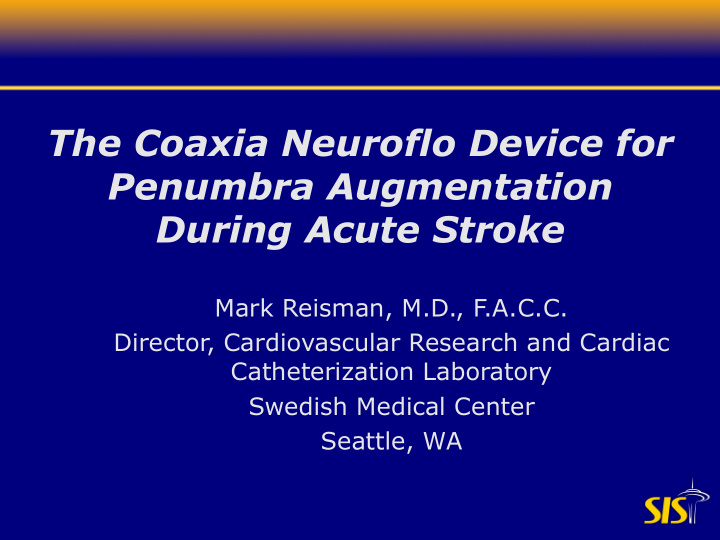



The Coaxia Neuroflo Device for Penumbra Augmentation During Acute Stroke Mark Reisman, M.D., F.A.C.C. Director, Cardiovascular Research and Cardiac Catheterization Laboratory Swedish Medical Center Seattle, WA
Presenter Disclosure Information Name: Mark Reisman, M.D. Within the past 12 months, the presenter or their spouse/partner have had the financial interest/arrangement or affiliation with the organization listed below. Nothing To Disclose
Time is Brain !
Acute Stroke Treatment • Recanalization: – Thrombolytics, Antithrombotic – Mechanical, Laser, Ultrasound • Neuroprotectors: Excitotoxicity – Anti-excitotoxic Impact – Anti-inflammatory – Anti-apoptotic Peri-infarct Inflammation • Manipulation of: depolarisations – Temperature – Blood pressure Apoptosis – Oxygen levels – Haemodynamics/rheology Minutes Hours Days Dirnagl et al. Trends Neurosci 1999
The MRI Approach DWI abnormality = infarct DWI/PWI mismatch = penumbra
The NCT/PCT/CTA Approach NCT/ PCT PCT PCT CTA Hemorrhage Ischemic Perfusion Vessel Injury Status Status Infarct Infarct Penumbra Large Vessel Sensitive, Early rCBF Intracranial & Detection rCBV Extracranial Quantified MTT Occlusions TTP
Surrogate Marker for Drug Effect PCT showing decreased stroke volume with thrombolytic drug
Goal of treatment Successful treatment Penumbra Final Stroke Size Infarct Unsuccessful treatment Penumbra - (Final Stroke Size - Infarct) Success = Penumbra
Penumbra / Infarct Ratio Favourable prognosis: High LSI → considerable improvement of NIHSS Lausanne Stroke Index = Pénombre Pénombre + Infarctus Unfavourable prognosis: Low LSI → no improvement of NIHSS Annals of Neurology 2002;51:417-432
Stroke Index 100% Blue: INCLUSION Red: EXCLUSION 0% 1/3 MCA territory Infarct Size
A New Approach to Treating Cerebral Ischemia • Globally increase cerebral perfusion via partial occlusion of descending aorta • Utilize extensive cerebral collateral network • Add volume and flow to the cerebral vasculature without systemic side effects • Salvage ‘at risk’ tissue immediately (penumbra) • Minimize risk of hemorrhagic conversion • No intracranial access required Core Penumbra
The Method: Partial Aortic Occlusion with NeuroFlo TM • Temporary, partial occlusion of descending aorta increases flow to carotids • Dual balloon aortic catheter • 9 Fr sheath; femoral access • Balloons advanced to supra- and infra- renal • Balloons sequentially inflated to 70% luminal occlusion • 45 minute inflation/treatment DESIGN / BENEFITS • Dual balloons and pressure measurements create stable, controllable occlusion • Cerebral perfusion increases 30% and persists beyond balloon deflation • Unique, supra- & infra- renal design preserves renal perfusion
Pre-Clinical Proof of Concept: Hemodynamics / Flow Swine Hemodynamics at 70% occlusion; n=8 cbfv 100 n=8 T=36.1-37.1°C Peak cbfv paCO2 = 27-30 mmHg 80 MAP Above Obstruction MAP Below Obstruction 60 % Change From Baseline Heart Rate Cardiac Output 40 20 0 -20 Device Inflation -40 -60 -20 0 20 40 60 80 100 120 Time (Min) • CBFV increases average >30% • Minimal systemic effect on MAP, HR and CO
Natural Progression of Infarct in Stroke CoAxia Non-treatment Patient Example (010-007) Baseline Map Follow-up Map % Change of summary map (Baseline vs Follow-up) Total area “At risk” “Infarct” - 5% - 50% + 22%
NeuroFlo Effect on Stroke Patient Post-NeuroFlo Pre-NeuroFlo % Change of summary maps (Pre vs Post-NeuroFlo) Total area “At risk” “Infarct” - 54% - 78% - 37% “At risk” penumbra resolves to normal
Clinical History • Pre-Clinical Studies – Rat, canine, porcine models; various studies – Validated perfusion increase w/o systemic effects; optimized design • Phase I Stroke (focus on safety) – Conservative, incremental balloon inflation – 9 US and European centers; 17 patients • Phase II Stroke (focus on outcome / perfusion) – Several minute inflation to target occlusion – 5 US centers; 12 patients • Phase I Vasospasm (focus on safety and outcome) – Single center (Buenos Aires) – Treatment evolved during the study; 24 patient
Human Feasibility Summary : Ischemic Stroke Total Treatment (n=29) Median NIHSS baseline 9.0 Mean time to treat (hrs) 7.6 + 2.2 Baseline NIHSS reduction > 3 61% (17/28*) peri-procedural NIHSS reduction > 3 62% (16/26**) or resolution (24 hr) 24 hours NIHSS 0-2 (24 hr) 27% (7/26**) Median NIHSS (24 hr) 5.0 Median NIHSS 30 days 5.0 *1 patient sedated peri- procedurally % reduction in median 44% ** 2 patients sedated plus 1 missing data point at 24 hrs NIHSS 30 days *** 2 patients died mRs < 1 30 days 37% (10/27***) (unrelated to procedure)
Human Feasibility Summary: Cerebral Vasospasm Peri-procedural Baseline NIHSS 10 Neurological Mean NIHSS reduction -3.4 Improvement NIHSS reduction ≥ 2 71% NIHSS reduction ≥ 4 43% Perfusion TCD 82% Augmentation Angiogram 67% 30 Day Neurological NIHSS < 2 13/16 (81%) Improvement Modified Rankin < 2 9/10 (90%)
Adverse Events Type of events # patients (%) No adverse events 9/29 (31%) Only non-serious events 12/29 (41%) Serious, non-fatal events 6/29 (21%) Deaths 2/29 (7%) All events adjudicated by Safety Review Committee: No deaths considered to be device- or procedure-related 1 serious AE considered procedure-related (groin hematoma) 8 non-serious AEs considered procedure-related: 5 groin bleed / hematoma 1 allergic reaction 1 vaso-vagal reaction 1 mild neurologic deterioration
Feasibility Results Have Led to Pivotal Trial SENTIS Stroke Trial • Pivotal, randomized trial for ischemic stroke is FDA approved and ongoing • NeuroFlo vs. medical management • Up to10 hours post symptom onset • 90 day neurological recovery as primary endpoint – pre and post Tx perfusion imaging data – secondary endpoint • 40 sites – 25 currently in process; seeking up to 15 additional sites
Conclusion • An interventional treatment for stroke victims beyond the 3 hour tPA window (up to 24 hours if penumbra?) • Wide availability due to ease of use and early data on safety • Role for interventional cardiology in acute stroke We hope to have more data and acute We hope to have more data and acute outcomes to present at TCT 2006 outcomes to present at TCT 2006
Recommend
More recommend